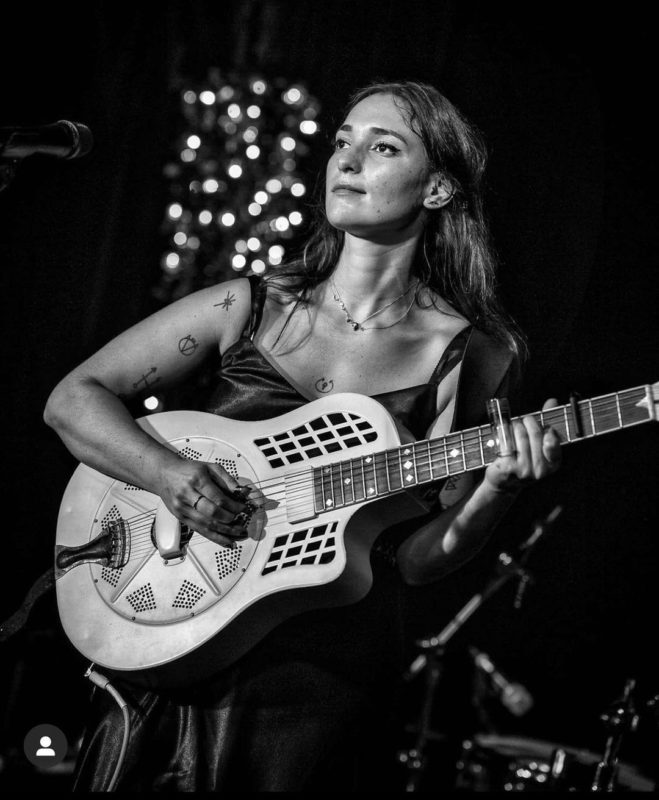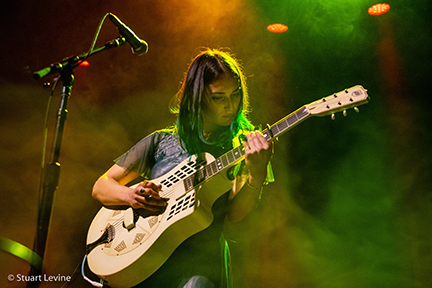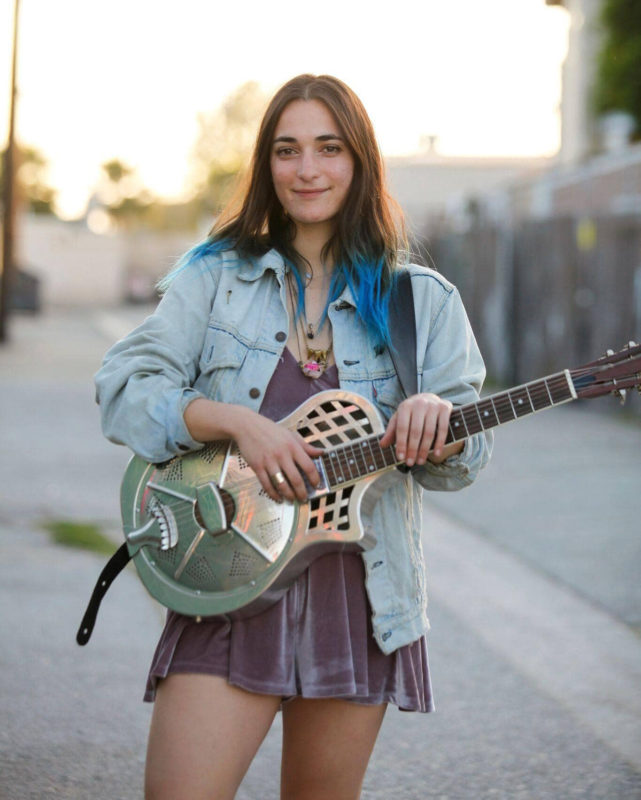by Frank Matheis 2021

Each year about 100,000 albums are officially released in the US, not even counting the numerous self-published recordings. Literally millions of albums are accessible through streaming or physical mediums. Roots & Blues constitutes less than .05 % of those sales. Despite that, 2021 has been a breakthrough year for amazing women artists in the related singer/songwriter, roots & blues, Americana genres. Wonderful artist have found fame: Sierra Ferrell, Allison Russell, Amythyst Kiah, Valerie June, Joy Oladokun, Rhiannon Giddens, Larkin Poe and Yasmin William.
There is a fine new youngblood gathering momentum on the block, and she deserves soon to be counted among those successful peers. Still somewhat under the radar, but rapidly rising, the songstress Cristina Vane out of Nashville, Tennessee, is a unique roots & blues, Americana singer/songwriter, guitarist and banjoist. Her life story is as interesting as her musical expressions. In many ways she is the embodiment of musical cross-culturalism and the powerful global impact of the African American blues. The young chanteuse is American/Guatemalan. She was born in Italy and grew up between England, Italy, and Paris, France. She left Europe when she was 18 to attend Princeton University, in New Jersey, to study comparative literature. Once she graduated, she moved to Los Angeles and then to Nashville. Now, she is on the verge of a deserved major breakthrough, not just because of her acoustic blues. Her new album Nowhere Sounds Lovely, from 2021, exceeds narrow notions of musical lineage, as would be expected from a musical internationalist. The triumphant album, on the small record label Red Parlor Records, is a stunning collection of powerfully impressive original songs that straddle the bluesy Appalachian/Americana/Roots rock sphere. If there is any justice, this album alone should catapult her high up on the recognition scale. She brings together old-time musical leanings with a heavy Appalachian vibe, blues-inflected, but broadly and unabashedly American roots music.
That genre fluidity is irrelevant to most serious music listeners who understand and appreciate musical diversity. On many levels, they get that all those sub-genres come out of the same socio-cultural amalgam. Some blues purists may disagree. They will nonetheless dance on the table from joy as yet another very talented young singer is keeping the acoustic blues vibrant. Anyone who hears her self-produced 2020 acoustic Delta blues EP Old Played New will be delighted. She is a fierce singer and slide guitarist in the orbit of trailblazer Rory Block, who Vane admires.
Cristina Vane is golden voiced, fierce on the National guitar and passionate in her delivery. One listen to her swift fingerpicking, alternate bass version of Robert Wilkin’s That’s No Way to Get Along is enough to raise eyebrows and proves her deserved place as one of today’s great new talents.
thecountryblues.com caught up with Cristina Vane via telephone from Nashville, Tennessee on November 23, 2021 and let her tell her own story:

“I never have and don’t claim to be a purist or a traditionalist in the blues. I really love and respect the tradition and the forefathers and mothers of the blues, all the women and men who have influenced me deeply. People should not expect me to sound like that, or even to try to sound like that. It’s really hard to sound like these people. They were unbelievably talented and had their own style and their own set of historical challenges that they were overcoming. I guess that I don’t belong in the box with the word “blues” on it. But I love the blues. It’s a huge part of my life. It’s a huge part of my music – but it’s just a part. I never claimed to be an example for the blues. It’s just there, and if you don’t see it, that’s okay.
I started playing music at a very young age. I was always singing. My parents told me that I sang to myself in the crib – that they could hear me over the baby monitor. I started piano lessons in first grade at six years old. I was in choir most of my I youth. I picked up the flute at 13 and really fell in love with that instrument. Around the same time, in Italy, I was taking music theory and voice and guitar lessons at a tiny little music school in my town called Varese. That’s when I first started guitar. I started writing songs in high school, but I still wasn’t into folk music or Americana. I didn’t know anything about the blues yet. I had never seen or heard a slide guitar. I started songwriting when I was about 16 or 17. I didn’t get into Delta blues and country and banjo and all that until much later after I graduated college in 2015. Before that, I was listening to a lot of rock and indie music. I was a product of the ‘90s. I loved grunge music and Nirvana and Audioslave, and then heavy music like Metallica and Megadeth. Punk music was very big in my life. I really loved indie music in college. I was listening to a lot of Bon Iver and the Strokes. The British indie scene was really big for me growing up. A lot of electronic music too, actually. I really enjoyed minimal house music. In Europe there’s a big electronic scene, so I would go to see DJs throughout my time in college. I also got into ‘90s rap. When I graduated, I found Rory Block’s tribute records. Rory opened the door into this whole new world for me. Oddly, Led Zeppelin too – because at the same time I found Rory Block’s Skip James tribute I was listening to In My Time of Dying – the Led Zeppelin recording and I thought to myself: This doesn’t sound like that they wrote this song. I looked it up and it’s an old spiritual that was first recorded by Blind Willie Johnson in 1927. I just fell in love with the original, and I fell in love with Skip James. Then I heard Mississippi John Hurt and that just captured my imagination in a way. It was really Bind Willie Johnson, because between him and Skip James it really gave me the chills and made me want to dive further into this kind of music. So I did.

When I moved to Nashville in 2018, I got a job at a guitar shop and I worked odd jobs as well, like weeding gardens or helping people out. Since the tornado hit us, I lost my job and then literally two months later was the 2020 pandemic. Since then, I have not gone back to a day job. I’ve been able to just play music. I also do commercial acting, and have done a few ads and things like that, which helps a lot. Also, I teach country blues guitar, slide guitar, and claw hammer banjo, plus I do remote recordings.
I play slide and fingerpicking guitar. When I was in Los Angeles after college in 2014, I worked at McCabes Guitar Shop, which is a folk music staple. One of the teachers, Pete Steinberg, became my mentor. He specializes in Travis picking fingerstyle guitar. He taught me how to play fingerstyle – some Jerry Reed and Son House.
On my last record, Nowhere Sounds Lovely, I play banjo, and I’ve gotten really into old time music. There’s some bluegrass and old-time sounds. There’s a tiny bit of country that seeped its way in, because I started listening to country music the summer that I wrote that record. I listened to a lot of Hank Williams.
One of the absolute highlights of my life really as a musician was opening for Bob Weir and Wynonna Judd at the Filmore in San Francisco. That would be the biggest and most amazing show I ever played. I’ve had some other really cool moments, but you know this last run in the Northeast was very fulfilling. I had two sold-out shows – which was a first for me – even though they’re small that’s still exciting. I have enjoyed great hospitality and really sweet people and great fans that came out to watch the show – especially in New York in a small bar called Skinny Dennis.
I just signed with a booking agency for the first time and that’s really exciting. I will be finishing my second full-length record, which is also very exciting. So what’s ahead is releasing that and then touring all of next year and just getting the word out.

My songwriting process is pretty simple. I usually will come up with a riff or a chord progression on the guitar. Once I have one that sounds good, I start playing it over and over, and then I start singing a melody that comes to me. I fill in the words last. My songs on that record are about places or new experiences, or Utah, or the majestic mountains of Zion or other cool things that I was discovering. On this next record there’s a lot more return to personal relationships or being hurt by people or enjoying people or whatever it is.
My main influences are Blind Willie Johnson’s melodic guitar playing. He really influenced how I play slide. He plays a lot with Travis style bass line and then these really, really beautifully done melodies over the top that he’s usually playing on his highest strings. That informed how I play. Mississippi John Hurt’s thumb is a big influence for me. I try and get a similar intensity from my right hand. I was in London, where my father lives, home from college for the summer. I was playing my first gigs in 2013 or so, and this band came, Sam Green and the Midnight Heist. Sam Green played a lapsteel and it was the coolest thing I had ever heard. I just wanted to mimic that sound. Actually, before that I had never even heard of any blues people. I was playing slide by myself in my dorm room in college, thanks to Sam Green – and I was writing songs too. I hadn’t heard about the blues yet.
I don’t want people to think of me in any one single way. It’s tricky when you put out a lot of video content, because sometimes that’s all people are seeing, and so they’ll see a video of me playing traditional style or unplugged or a cover of a Blind Blake song or a John Hurt song and they think that that’s all I do. It would be a true honor to be only playing that blues style – but I don’t. I play lots of different things, and I think that’s what’s exciting about a lot of other contemporary blues people is they’re usually coming at the genre with a little bit of other influences, and you can hear it. It’s not a straight carbon copy.”
Cristina Vane’s star is deservedly rising. Roots & Blues fans rejoice.


